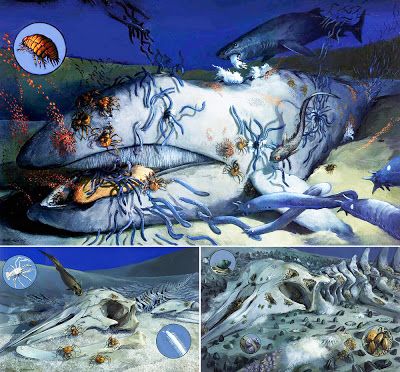Scavengers Of The Ocean Floor

Crabs will eat just about anything and are known as professional garbage hunters.
Scavengers of the ocean floor. A whale fall may occur as frequently in the deep ocean as one in every 20 25 kilometers of seabed. Lobsters are nocturnal bottom walkers and scavengers that scavenge for dead animals and debris on the ocean floor they are like the vultures of the oceans. Dubbed zombie worms these polychaetes of the genus osedax were discovered living in the bones of a gray whale carcass 10 000 feet deep. When a whale or other large marine animal dies and falls to the ocean floor different waves of decomposers and scavengers feed off the carcass until nothing remains.
Herding zombies into deep benthik depth would over time dissolve the flesh. In the past not much was known about the life forms that live there but current research has given scientists a great deal of new information about the species that reside at this level and their methods of survival. Many creatures thrive in oceans waters. A whale fall occurs when the carcass of a whale has fallen onto the ocean floor at a depth greater than 1 000 m in the bathyal or abyssal zones.
Salt water at deep ocean pressure becomes a sort of salt acid as high pressure concentrates saltwater into brine. Here many different scavengers gather to enjoy a dead tuna carcass. Way vol dun 26 79 52 91 ofer s bound journal first floor blue stone table way vol dun 52 43 14 39 julien s left boot near the bones close to the cliff way vol dun 47 06 75 77 zach s canteen under the stairs. On the sea floor these carcasses can create complex localized ecosystems that supply sustenance to deep sea organisms for decades.
Inevitably the scavengers had scattered pieces of flesh around the whale carcass and native microbes had multiplied quickly around those scraps. Since scavengers are limited on the floor of the ocean several years may be required for the consumption of whales. They have no eyes mouth or stomach but are able to eat by secreting an acid through their skin that allows them to dissolve the bones of dead animals and unlock the fats and proteins inside. Do you think this is an example of succession.
Since light and food is so scarce fish have developed large eyes slow metabolisms weak muscles and elongated bodies. In the course of about six months they had eaten most of the skin and muscle. That brine leaches away bone calcium and breaks down soft tissue. Lobsters have even been seen burying dead fish and digging them up a little at a time to eat.
This is unlike in shallower waters where a whale carcass will be consumed by scavengers over a relatively short period of time. Whale falls were first observed in the late 1970s with the development of deep sea robotic ex. Scavengers of the deep ocean floor. December 20 2019 welcome to the feast in the deep.
Giant isopods crabs and deep sea eels devour the carrion leaving nothing but a skeleton on the ocean floor.


















